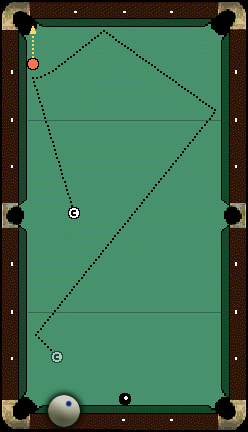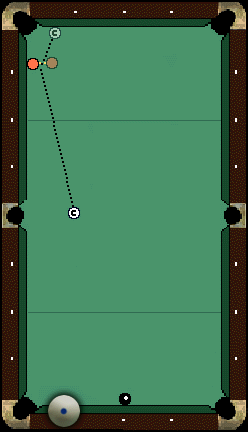
Would You Go For It Or Play Safe?
by Jim Meador
New players have a difficult time keeping safety options on the front burner. Many will carefully study the table trying to decide where to sink the object ball, and never see an obvious game winning safety. I believe it is a mind set, partly due to preconceived notions about the game acquired by years of watching pool segments on TV, or in movies such as The Hustler, or The Color of Money. In the movies, the star is shown sinking several balls at once, or performing beautiful massť shots. One never sees a safety play, because a safety may not "look" impressive to an uneducated movie audience. But in real life, the pros use safeties frequently, and to the applause of an appreciative audience. In fact, a well timed safety can snatch victory from the jaws of defeat.
Ball in hand is the best possible position, and safety shots can often result in a ball in hand foul against your opponent. The best safety contest I have witnessed personally was between Efren Reyes and Nick Varner. They traded four or five consecutive safeties, each player executing remarkable escapes, and in the process, leaving the other safe. The audience stayed on i'ts feet. So, safety play is one of the more exciting aspects of the game. "Going for it", when the situation calls for a safety does not demonstrate courage or fair play. It demonstrates something akin to carelessness.
The time to play a safety depends on several factors. One is the level of play. Another is the number of balls you and your opponent have remaining on the table. The third factor relates to the risks involved in the offensive shot you are faced with- what are the odds of missing, and if you do miss, can you leave your opponent with a poor response. If your opponent is not advanced, and there are enough balls on the table to make it unlikely that he or she will run out, trying to sink a low percentage shot may be a reasonable risk. However, advanced players will opt for a safety rather than run the risk of leaving their opponent open. In one stroke, a well played safety can reverse an opponent's advantage- even a strong advantage.
The way to learn when and how to use safeties is to practice them the same way you practice any other shot. Set up safety situations during practice by placing the cue ball and an object ball in locations that would make it difficult to pocket the object ball. Place an imaginary "opponent's" ball in the open. Now, try to hit your object ball so as to hook the opponent. There is no end to the possible safeties you can set up and practice. You will discover that speed is the key to safety play. In fact, practicing safeties will also improve your offensive game by improving your overall feel for speed and control.
You will improve your winning percentage significantly when you learn to place defensive and offensive strategies on an equal level. My guess is that, at an advanced level, offense and defense are equally responsible for a high winning percentage. So, don't give your opponent an easy win. When you approach the table, look for a safety that could give you ball in hand, even if you have an open shot. With ball in hand, you can take control of the table, and control is what the game is about, if you expect to win.
Above Left: It is your shot, and you have an easy shot at the 4-ball. But, the 8-ball is at the other end of the table. An advanced shooter might use the spin shown and travel around the table for an easy eight. However, the spin put on the cue to get to the 8-ball can cause the 4-ball to hang up in the pocket, and a miss leaves your opponent with the position on the 8-ball that you planned for yourself. Not good.
If you are not an advanced player, select the safety below. Shoot easy and graze the 4-ball with just enough speed to reach the bottom rail. Even if the four does not come out far enough to snooker the cue, it could at least block the pocket, and it is not easy to cut or bank the 8-ball from this position. With the 4-ball in the jaws of the pocket, a return safety is all but impossible. This is a game winning safety.

Note: There are many situations near the end of a game when you do not want to sink your last ball. Never feel compelled try a shot that you might miss if it will leave your opponent on the money ball, regardless of what others might think. Remember, you are playing to win.